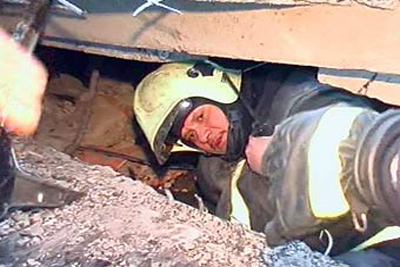
TRAGEDY AT MOSCOW MARKET REVEALS XENOPHOBIA AMONG RUSSIAN PUBLIC
Publication: Eurasia Daily Monitor Volume: 3 Issue: 40
By:

On February 23 the roof over Moscow’s Basmanny market collapsed from a combination of snow buildup and questionable construction. Two years ago a similar accident took place at the Transvaal water park in Moscow, taking the lives of 28 people. Both projects had the same architect. The latest incident killed at least 66 people, mainly non-Russians. Among the victims, there were 45 Azerbaijani citizens, eight from Georgia, five from Tajikistan, and three from Uzbekistan. Many had come to Russia as labor migrants, living and working at the market.
The collapse of the Basmanny market provoked aggressive reaction from the Russian public. Some worried that had the market collapsed during business hours, instead of 5:15 am, more people would have died. Labor migrants from Azerbaijan and other post-Soviet states were blamed for misusing the market’s facilities.
Along with expressing condolences about the death of people and concerns about the government’s poor control over buildings and construction, the Russian media revealed some latent xenophobic feelings among the Russian public. For example, in a public opinion poll conducted by Komsomolskaya pravda newspaper, more than a few people expressed disgust with the labor migrants, using the derogatory term “chornye” (blacks): “We are not animals, but ordinary Muscovites have uninvited guests more than our souls can embrace,” was a typical comment. Other respondents disagreed with Moscow mayor Yuri Luzhkov’s order to allocate 100,000 rubles (about $3,500) to each family that lost relatives in the accident. As one Moscow resident griped: “It would be better to have this money dispensed to pensioners” (Komsomolskaya pravda, February 26).
Moskovsky komsomolets suggested that the Azeri mafia operating at the Basmanny market had suffered the consequences of its violent competition with other ethnic groups from South Caucasus (February 26). The newspaper also commented that some Muscovites liked the market for its low prices, while others detested it for the dominance of traders from the South Caucasus states. The tragedy also provoked numerous Internet discussions between Russians and Azeris regarding the causes and repercussions of the tragedy.
The accident inevitably raised the issue of persisting cleavages between communities of labor migrants in Russia and local residents. It reminded that Russian society is socially and economically divided into two distinct groups: locals and labor migrants from the former Soviet states, mostly from South Caucasus and Central Asia. The Basmanny market was one of the larger enclaves of labor migrants residing in Russia, often without legal status. According to various estimates, there are about 4 million labor migrants across Russia. Most of them are non-Slavic nationalities.
While some Russian residents are unhappy about the large inflow of labor migrants, the country needs foreign workers due to its dwindling population (see EDM, February 10). At the same time, many migrants are forced to seek jobs in Russia because of the poor economic conditions in their native countries. For example, there are about one million Tajik migrants working in Russia, whose annual remittances constitute $6-8 billion, roughly the size of Tajikistan’s GDP. Labor migrants encounter numerous difficulties upon their arrival in Russia. Due to inefficient government regulations on migration, the procedure for attaining legal status and a work permit is lengthy and selective. Often labor migrants are regarded as a source of crime, including theft, looting, beatings of local residents, and rapes.
Besides law-enforcement agencies, labor migrants face strong aggression from extreme nationalist, neo-Fascist movements in Russian cities. In particular, these skinhead movements are active in Moscow, Saint Petersburg, and Nizhny Novgorod. The movements are usually comprised of young people, 16-35 years old, with a strong ideology, somewhat charismatic leaders, and aggressive attitudes towards non-Russians. These movements commit hate crimes against foreigners, and labor migrants are one of their favorite targets. On February 26 a group of teenagers attacked two Kyrgyz women in Saint Petersburg. One woman died from multiple knife injuries. In an infamous case from February 2004, a 9-year old girl from Tajikistan was killed by aggressive youth in Saint Petersburg.
The Russian authorities have pledged to investigate the causes of the deadly accident at the Moscow market. However, the deeper issue of societal cleavages remains unaddressed. As Komsomolskaya pravda concludes, the tragedy at the Basmanny market represents the general situation in Russia that can be compared with a communal house: in case of a collapse, it will harm both the hosts and the guests (February 26).




